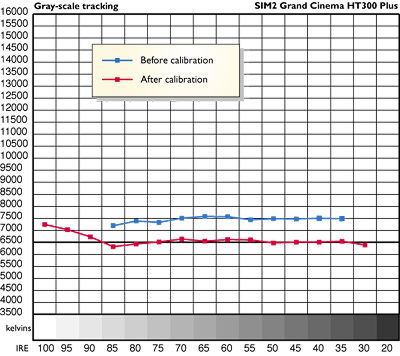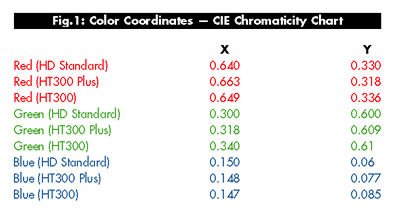SIM2 Grand Cinema HT300 Plus 16:9 DLP projector Calibration
The color-temperature readings for the first sample of the SIM2 Grand Cinema HT300 Plus are shown in the accompanying figure. The Medium and High settings are not shown, but measured approximately 8500K and 12,000K, respectively. Before calibration, at the Low setting, the maximum light output on my Stewart FireHawk screen (80 inches wide, 16:9) measured 12.7 foot-lamberts. After calibration, this dropped to about 9.8ft-L.

If you have the HT300 Plus professionally calibrated (which we recommend), I suggest that you have the adjustments performed in one of the preset color-temperature settings, perhaps Medium, rather than the User setting. That way, if someone switches to the User color temperature setting and fiddles with the R, G, and B controls, those random, possibly unwanted changes will not affect the fixed color calibration in the Medium setting. (The user-level R, G, and B settings do not operate in the three fixed color-temperature options—those options can be adjusted only via the service menu).
I took three different types of contrast measurements, all of them on the Stewart FireHawk screen. In the following discussion, the results in parentheses are the readings we got when we measured the original HT300 under the same conditions (SGHT, June 2002). Note that the room in which these measurements were taken is light-controlled, but the walls are not black, so these results should be considered comparative, not laboratory absolute. Such measurements will rarely, if ever, confirm a manufacturer's spec, not only because the environment is different, but because the measurements were made with the projector set up to produce the best picture we could get from it in all respects (including a properly calibrated gray scale), not just to obtain the biggest contrast numbers.
Nevertheless, the contrast results for the HT300 Plus were impressive, and clearly an improvement over the HT300. Full on/full off measured 908 (495). (Full on = the center of a 100 IRE full white field, full off = the center of a black field produced by selecting an unused input.) A 16-square ANSI checkerboard measured 130 (105). Comparing the center of the 100 IRE window with the average of several points midway into the black border around the window yielded 398 (274).

But there's more. Our second sample measured even better: full on/full off was 1595. The difference was visible onscreen. At these levels of contrast, the light output from a full-black screen is so low that the exact number is subject to the tolerances of our Minolta LS-100 light meter. The Minolta will read down to 0.001ft-L (not low enough to capture a reading for the open-input black level on a good CRT display!), but small differences in the measurement will cause huge differences in the final measured contrast ratio (the denominator in the full on/full off ratio is a very small number). Suffice it to say that the SIM2's measured contrast was impressive, and the results were clearly visible onscreen with real program material.—TJN























































